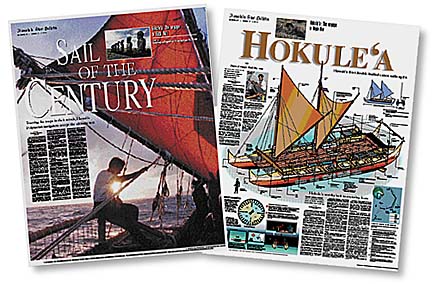

Trusting the maps in their minds,
By Susan Kreifels
Hawaii's Polynesian navigators
accept the ultimate test
Star-BulletinOver thousands of miles these Hawaiian navigators followed the stars, proving the skills of their ancient Polynesian ancestors, honoring them in a world that had forgotten.
They sailed to distant shores of Polynesian cousins who welcomed them with chants and gifts of turtle and fish. They felt a common heritage, a renewed pride.
Now the celestial navigators embark on their most difficult, most important voyage of the last 25 years as they prepare pass on their dreams to a second generation of voyagers.

The Hokule'a, Hawaii's first traditional voyaging canoe and symbol of native Hawaiian resurgence, is setting sail for Rapa Nui (Easter Island). This last sail of the century will complete the triangle of ancient migration routes the Hawaiians have retraced through the Pacific. It also ends on shores with a tragic history, perhaps most in need of spiritual guidance and restoring Polynesian pride.The 1,450 miles from Mangareva to Rapa Nui will be the toughest the Hokule'a has ever sailed. Against prevailing winds, and relying only on the stars, the waves and the maps in their minds, the best of Hawaii's navigators will head for the most isolated inhabited island in the world. Only 50 square miles in size, Rapa Nui lies 1,400 miles from the nearest island, making it extremely difficult to find without navigational equipment.
The voyage home will be just as historic, bridging the last quarter century of traditional sailing to the next millennium. First-generation voyagers will observe the new, testing those who show leadership. The responsibility of Hokule'a -- teaching the children of Oceania to care for their environment and community, and to use science and technology within their culture to protect, not destroy -- will then be handed to a new captain and second generation of star navigators.
"To me personally, this is the most important voyage," said Nainoa Thompson, captain of Hokule'a. "It's our investment in the future, transmitting the things we hold so important to those not even born."

"To me personally, this is the most important voyage," said
Nainoa Thompson, captain of Hokule'a, shown during a
recent shakedown in Hawaiian waters. "It's our investment in
the future, transmitting the things we hold so important
to those not even born."
The crew home will include the best teachers and students. Mau Piailug, the revered "papa" from Micronesia who taught Hawaiians the navigation of their ancestors, will be aboard. So will the oldest: 79-year-old Wallace "Uncle Wally" Froiseth.And the youngest: Ka'iulani Murphy, 20, a Hawaiian studies major and presidential scholar at the University of Hawaii.
Kamaki Worthington, 27, is one of the young generation on the Rapa Nui voyage who feels the responsibility. A former bank-loan employee, he now is an educator with the Polynesian Voyaging Society and in charge of the canoe's seaworthiness. "It's on our shoulders what the next 25 years are going to be," Worthington said.
Part of the Hokule'a mission has been a program called Malama Hawaii. Its goal: to foster a healthier community and environment by strengthening the Hawaiian culture, what Thompson calls the "whole issue of self-esteem building."
Promoting a healthy, sustainable environment is an important focus of the Rapa Nui voyage. The island, discovered by ancient Polynesians, was home to the most skilled of the Polynesian carvers, creators of the mammoth stone heads called "moai."
But the island lacked fresh running water and had fewer indigenous plants and animals. The delicate ecosystem was destroyed by too many people -- the population reached as high as 20,000 in the 17th century. By 1877, spent resources, wars and diseases introduced from the West had diminished the population to 111.

Rapa Nui, much like Hawaii before Hokule'a, has lost touch with its Polynesian roots, entangled in Spanish and Chilean culture.Sergio Rapu, one of a handful of Rapa Nui people who live here, looks to the Hawaiians to help restore ancestral traditions and cultural pride in his home island.
He also believes Hawaii experts can help restore a healthy, sustainable environment for the 2,100 native people left on the island -- total population, 3,000. "The trip of the Hokule'a to us is a gift," said Rapu, a former governor and director of the island's Institute of Pacific Study. "It brings in tremendous symbolic value."
Thompson looks to the Rapa Nui voyage as an invaluable lesson for Hawaii's children about protecting the environment.
Educating young Pacific islanders is the most important mission of the Hokule'a. The voyage will be tracked by 100,000 students throughout Hawaii and 1 million worldwide via Internet and satellite telephone and radio calls from the canoe. They also will be following a special classroom curriculum.
UH crew member Murphy sees her time with the Hokule'a as providing some of life's best lessons. Part Hawaiian from the Big Island, she feels a loss of words when she tries to describe her feelings for the canoe. It makes her even more proud of her heritage and the accomplishments of her Polynesian ancestors.
Murphy's "kupuna," or family elder, "grew up ashamed to be Hawaiian, ashamed of her brown-colored skin. Now I'm proud of it."
HOKULE'A WEB CAMERA
The Hokule'a has a Web camera on board.
Access images during the voyage at:
Web camera to access images during the voyagehttp://leahi.kcc.hawaii.edu/org/pvs
